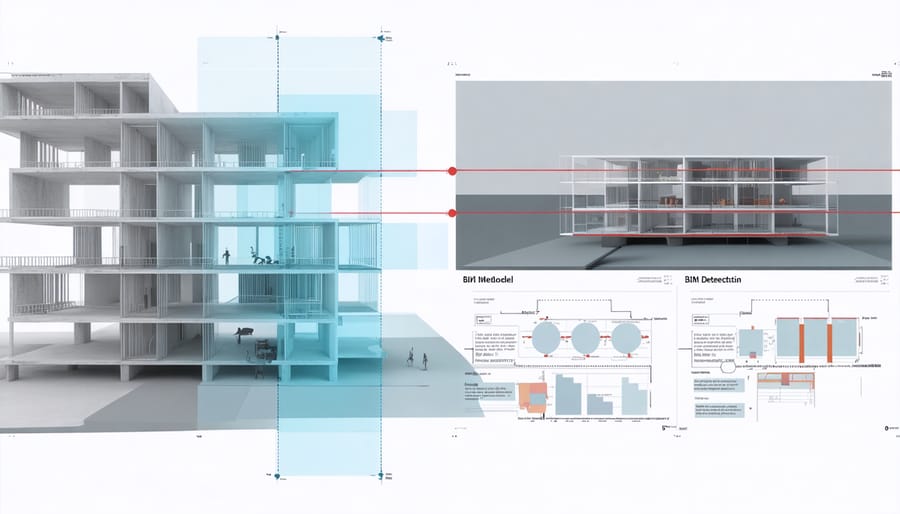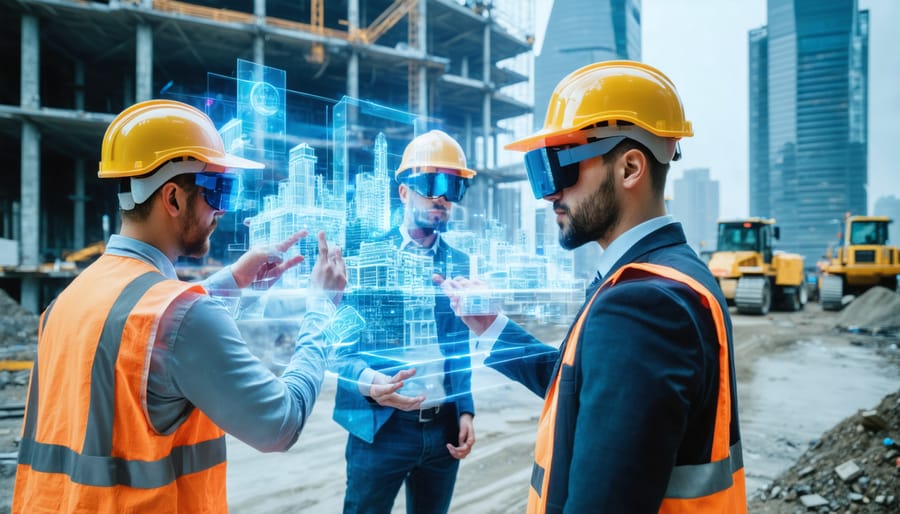Building Information Modeling (BIM) merged with augmented reality (AR) is revolutionizing construction project visualization and execution, enabling real-time overlay of 3D models onto physical construction sites. This powerful integration allows construction professionals to detect clashes, verify installations, and make informed decisions directly in the field, reducing errors by up to 40% and accelerating project timelines by 25%.
Today’s construction managers leverage BIM-AR solutions to bridge the gap between digital models and physical reality, transforming how teams interpret complex spatial data and coordinate multiple trades. Through mobile devices or AR headsets, stakeholders can visualize hidden infrastructure, compare as-built conditions against design specifications, and collaborate effectively across disciplines.
The convergence of BIM and AR technology marks a significant shift from traditional construction methods to data-driven, visualization-enhanced project delivery. As the construction industry embraces digital transformation, BIM-AR applications are becoming essential tools for quality control, progress monitoring, and stakeholder communication, delivering unprecedented accuracy and efficiency in construction operations.
This integration represents more than just technological advancement; it’s a fundamental change in how construction projects are conceived, executed, and managed in the modern era.
The Convergence of BIM and AR Technology
Technical Infrastructure
Implementing BIM-AR solutions requires a robust technical infrastructure comprising both hardware and software components. At the foundation lies 3D BIM modeling fundamentals, which must be supported by high-performance workstations capable of handling complex 3D renderings and real-time processing.
Essential hardware components include AR-enabled devices such as smart glasses (like Microsoft HoloLens or Magic Leap), tablets, or smartphones with sufficient processing power and sensors. These devices must feature high-resolution displays, accurate positioning systems (GPS), and motion tracking capabilities (accelerometers and gyroscopes).
On the software side, organizations need BIM authoring tools (such as Revit or ArchiCAD), AR development platforms (Unity or Unreal Engine), and specialized BIM-AR integration middleware. Cloud infrastructure is crucial for data storage, processing, and real-time collaboration. Network requirements include high-speed internet connectivity with minimal latency, particularly for on-site applications.
Security protocols and data management systems must be implemented to protect sensitive project information while ensuring seamless access across authorized devices and users.
Data Integration Framework
The integration of BIM models into AR environments requires a sophisticated data translation framework that maintains model fidelity while optimizing performance. This process typically involves converting detailed BIM data into lightweight, AR-compatible formats through specialized middleware platforms. The framework operates on three key levels: geometry optimization, metadata preservation, and real-time synchronization.
At the geometry level, complex BIM models are simplified through automated mesh reduction algorithms, maintaining visual accuracy while reducing polygon counts to ensure smooth AR performance. Critical metadata, including material specifications, installation instructions, and maintenance schedules, is preserved through structured data mapping protocols.
Real-time synchronization enables live updates between the BIM source and AR visualization, ensuring that any changes made to the design are immediately reflected in the AR environment. Modern integration frameworks utilize cloud-based solutions to manage data flow and version control, allowing multiple stakeholders to access and interact with the same model simultaneously.
Industry-standard formats like IFC (Industry Foundation Classes) and glTF serve as intermediate conversion steps, ensuring compatibility across different platforms and devices while maintaining the semantic richness of BIM data throughout the translation process.

Real-World Applications in Construction Management
On-Site Visualization
On-site visualization through BIM augmented reality transforms how construction teams interact with building information models in the field. By overlaying digital BIM data onto the physical construction environment through AR-enabled devices, workers can instantly access and visualize critical project information in real-time. This integration of virtual design and construction with physical spaces enables unprecedented accuracy in construction execution.
Using AR headsets or mobile devices, field personnel can view full-scale 3D models superimposed directly onto the construction site. This capability allows workers to verify installation positions, detect conflicts between designed and as-built conditions, and ensure compliance with project specifications without referring to 2D drawings or desktop computers.
The technology enables instant comparison between planned and actual construction progress, helping teams identify discrepancies early in the building process. Project managers can conduct virtual walk-throughs with stakeholders, visualizing completed sections alongside areas still under construction. This real-time visualization capability significantly reduces errors, accelerates decision-making, and improves communication between office and field teams.
Furthermore, AR-enabled BIM visualization supports quality control processes by allowing inspectors to overlay approved designs onto completed work, ensuring precise adherence to specifications. This immediate visual feedback loop has proven particularly valuable in complex MEP installations and structural component placement, where spatial accuracy is crucial.

Clash Detection and Resolution
Clash detection through augmented reality represents a revolutionary advancement in BIM implementation, enabling construction teams to identify and resolve potential conflicts before they materialize on-site. By overlaying BIM models onto the physical construction environment, AR technology allows professionals to visualize potential interference between building systems, structural elements, and mechanical components in real-time.
Project managers and engineers can walk through construction sites wearing AR-enabled devices, instantly spotting conflicts between designed elements and existing conditions. This immediate visualization capability significantly reduces the risk of costly rework and schedule delays. For instance, teams can detect conflicts between HVAC ductwork and structural beams, or identify where plumbing systems might interfere with electrical conduits.
The resolution process becomes more efficient as stakeholders can collaborate in real-time, viewing and discussing conflicts while physically present at the location. AR-enabled clash detection supports dynamic decision-making by allowing teams to test multiple solutions virtually before implementation. According to industry studies, this approach has reduced clash-related delays by up to 90% on major construction projects.
Key benefits include:
– Early identification of spatial conflicts
– Reduced coordination meetings and RFIs
– Improved accuracy in conflict resolution
– Enhanced stakeholder communication
– Significant cost savings through preemptive problem-solving
Construction teams implementing AR-based clash detection report substantial improvements in project delivery times and reduced on-site conflicts, making it an invaluable tool for modern construction management.

Progress Monitoring
Progress monitoring in BIM-enabled AR systems revolutionizes the way construction teams compare as-built conditions with planned designs in real-time. By overlaying virtual BIM models onto the physical construction environment through AR devices, project managers can instantly identify discrepancies between design intent and actual construction progress. This integration with construction site monitoring enables teams to detect and address issues before they escalate into costly problems.
The system works by capturing the existing site conditions through various sensors and cameras, which are then automatically compared with the BIM model’s planned specifications. Project managers wearing AR headsets can walk through the construction site and see color-coded overlays highlighting areas where construction deviates from the design, including dimensional variances, misaligned components, or scheduling delays.
This real-time comparison capability significantly reduces the traditional inspection time while improving accuracy. Teams can document discrepancies with integrated photo and video capture features, annotate issues directly in the AR environment, and share findings instantly with stakeholders. The system also maintains a digital record of all identified variations, creating a comprehensive audit trail for quality control and compliance purposes.
Key metrics such as percentage of completion, dimensional accuracy, and schedule adherence can be quantified and visualized through intuitive dashboards, enabling data-driven decision-making and proactive project management.
Implementation Challenges and Solutions
Technical Challenges
While BIM-AR integration offers tremendous potential, several technical challenges must be addressed for successful implementation. Hardware limitations remain a significant concern, particularly regarding mobile device processing power and battery life during extended on-site use. Current AR headsets often struggle with outdoor visibility and may become uncomfortable during prolonged wear, affecting worker productivity.
Software compatibility presents another major hurdle. Different BIM platforms and AR applications often use varying file formats and data structures, creating integration difficulties. Real-time synchronization between BIM models and AR interfaces can be problematic, especially when handling large, complex models with multiple layers of information.
Environmental factors also impact AR performance. Construction sites’ dynamic nature, varying lighting conditions, and interference from metallic structures can affect tracking accuracy and spatial recognition. Additionally, the need for precise GPS positioning and reliable internet connectivity poses challenges in remote or underground locations.
Solutions are emerging to address these issues. Cloud-based processing reduces hardware demands, while edge computing helps manage connectivity challenges. Advanced tracking systems combining multiple sensors (GPS, IMU, visual) improve accuracy and reliability. Software developers are working toward standardized formats and protocols to enhance interoperability between BIM and AR platforms.
To mitigate these challenges, organizations should conduct thorough testing in actual site conditions and develop contingency plans for technical limitations. Regular system updates and proper staff training are essential for optimal performance.
Workforce Adoption
Successfully integrating BIM augmented reality into existing workflows requires a structured approach to workforce training and change management. Organizations must develop comprehensive training programs that address both technical skills and mindset adaptation. These programs typically include hands-on workshops, online learning modules, and mentorship opportunities to ensure staff become proficient with AR tools and BIM interfaces.
Construction professionals need to master basic AR hardware operation, understand BIM model navigation, and learn to interpret augmented visualizations effectively. Training should focus on practical applications like overlay accuracy, spatial registration, and troubleshooting common issues. Industry leaders report that a minimum of 20-30 hours of initial training is necessary for basic proficiency, with ongoing support for advanced features.
Change management strategies should emphasize the tangible benefits of BIM AR adoption, such as improved accuracy, reduced rework, and enhanced collaboration. Successfully implementing these technologies requires clear communication channels, designated AR champions within teams, and regular feedback loops to address concerns and obstacles.
Organizations should establish metrics to track adoption rates and effectiveness, including user engagement levels, error reduction rates, and project completion times. Progressive implementation, starting with pilot projects before full-scale deployment, allows teams to adapt gradually while maintaining productivity. Regular assessment and adjustment of training methods ensure optimal workforce development and technology integration.
Future Developments and Industry Impact
The convergence of BIM and AR technologies continues to drive digital transformation in construction, with several groundbreaking developments on the horizon. Industry experts predict that by 2025, we’ll see the widespread adoption of AI-powered AR solutions that can automatically identify construction errors and suggest real-time corrections based on BIM data.
Wearable technology is expected to evolve significantly, with next-generation AR glasses offering improved comfort, longer battery life, and enhanced visual capabilities. These devices will likely integrate advanced sensors for precise environmental mapping and feature gesture-based controls for intuitive interaction with BIM models.
Cloud-based BIM-AR platforms are anticipated to become more sophisticated, enabling seamless collaboration between multiple stakeholders across different locations. Real-time synchronization of design changes and construction progress will become standard practice, significantly reducing communication gaps and decision-making delays.
The integration of Internet of Things (IoT) sensors with BIM-AR systems will enable dynamic monitoring of construction progress and building performance. This combination will allow project managers to visualize real-time data overlays, from structural stress measurements to environmental conditions, directly through AR interfaces.
Machine learning algorithms will enhance the accuracy of AR model positioning and improve the recognition of construction elements, leading to more precise overlay of digital information onto physical structures. This advancement will be particularly valuable for complex installations and quality control processes.
The construction industry can expect to see new applications in prefabrication and modular construction, where BIM-AR systems will guide assembly processes with unprecedented precision. These developments will contribute to faster construction timelines and reduced material waste, ultimately driving project efficiency and sustainability goals.
As these technologies mature, we’ll likely witness their integration into building maintenance and facility management, creating a continuous digital thread throughout the entire building lifecycle. This evolution will fundamentally reshape how construction projects are planned, executed, and maintained.
The integration of BIM and Augmented Reality represents a transformative development in construction technology, offering unprecedented opportunities for project optimization and efficiency. Through the combination of detailed 3D modeling and real-time visualization, construction professionals can now bridge the gap between digital design and physical implementation with remarkable precision.
The benefits of BIM-AR integration are clear and compelling. Projects utilizing this technology consistently demonstrate improved coordination among stakeholders, reduced errors and rework, enhanced safety protocols, and significant cost savings. Real-time visualization enables quick decision-making and problem-solving, while mobile accessibility ensures that crucial project information is available whenever and wherever needed.
As the construction industry continues to evolve, early adopters of BIM-AR technology are positioning themselves at the forefront of innovation. The investment in this technology, while initially substantial, typically yields considerable returns through improved project outcomes and operational efficiency. Furthermore, as hardware becomes more affordable and software solutions more sophisticated, the barriers to entry continue to decrease.
For construction professionals considering the implementation of BIM-AR solutions, the time to act is now. The technology has matured significantly, with proven success stories across various project types and scales. By embracing this innovative approach, organizations can enhance their competitive advantage, improve project delivery, and better serve their clients’ needs in an increasingly digital construction landscape.

